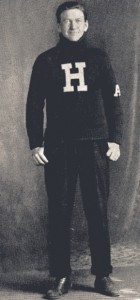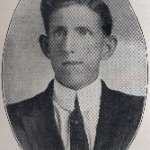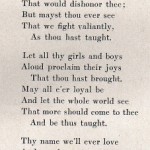(Excerpted from James F. Willis, Southern Arkansas University: The Mulerider School’s Centennial History, 1909-2009, pp. 60-62)
From the beginning, TDAS had athletic teams, including baseball, football, basketball, and track, and competed against other schools. Students played tennis, but that sport was apparently only for intramural contests. When TDAS opened in 1911, the board purchased uniforms in time for the spring baseball season and hired a young twenty-three-year-old history teacher to coach all sports; students named Coach Ruford Turrentine, in 1915, the school’s most popular teacher. A recent graduate of Henderson-Brown College in Arkadelphia, he had run track and played for three years on its championship football team, the Red Jackets (Reddies). A well-rounded and accomplished individual, he had earned both B.A. and B.S. degrees, completing requirements that included four years of Latin and two years of either Greek, French, or German. He had served as president of both the YMCA and Gamma Sigma Literary Society, sung in the male quartet, and spoken as commencement debater his senior year in 1909. At first a bachelor, like most of the other young teachers, he lived in the boys’ dorm. In 1912, he married domestic science teacher Lucile Benoit in a ceremony in a large room that served as the auditorium of Old Main.
TDAS athletes in the early years usually played high schools and only occasionally faced a college team. On the whole, whether in baseball, basketball, or football, surviving records document more losses than wins. Although many games were close, there was one notableexception—an 81–0 mismatch in 1914 with the Ouachita Tigers, the best college team in the state. The Muleriders may have been less crestfallen after they learned that the Tigers that year had also beaten the University of Arkansas Razorbacks. When the football team was first organized for the fall season in 1911, the board decreed, reasons unknown, that it could play only two games, both at home. The team lost both contests, the first to Texarkana High and the second to Camden. The Camden game, played on Thanksgiving Day, began a tradition common to many schools of scheduling a “Turkey Day” game. The Thanksgiving game with Fordyce in 1912, as explained in the introduction, led to the naming of the Muleriders. However, until the early 1920s, the team was more frequently called the Magnolia Aggies. During their first full season with six games in 1913, there was a contest with the visiting Monticello Aggie team, the Boll Weevils, which initiated the schools’ enduring rivalry. Home games were played at Smith Field (used later for Magnolia High School baseball) located near the campus’s southeast corner. There were no bleachers or lights, of course, and at afternoon games, spectators stood on the sidelines to cheer. There were student “yell leaders,” but the tradition of having a rider on a mule at games would not appear for a decade.
A hard-won victory, 7–0, over the Boll Weevils on a rainy Thanksgiving Day in 1915 provided a happy return for former students who came to attend the school’s first homecoming. That afternoon, the yearbook recorded, “was spent on the Athletic field and the sidelines were densely settled with students
and visitors to encourage our ‘Mule Riders’ with songs and yells.” That evening, alumni and the visiting team shared a banquet with students at the dining hall. J. M. Pickett of Chidester, a 1914 graduate, served as toastmaster. Nicknamed Tal, he had been a “big man” on campus, a star athlete and president of most every student organizations. He may have led the crowd in singing the school’s first alma mater anthem. Math professor A. C. Maddox had just written the song, “Dear Aggie School,” sung to the tune of “America.”
It was at track meets that the Mulerider teams won most often before the First World War. TDAS outran all the high school competition in the Camden Cup relays in 1914 and 1917. At the 1916 state meet in Pine Bluff, Conrad Lewis made a record high jump of five feet ten inches, some two inches more than the state record. At the state meet in 1917 in Little Rock, the team placed third overall and came in second in the college level relays ahead of Hendrix College but behind Henderson-Brown.




